Finding the Right Mobility Solution for Your Truck
A wheelchair lift for truck hitch is an exterior mounting system that attaches to your truck's receiver hitch to transport mobility devices without using interior space. These lifts provide independence and convenience for truck owners who need to transport wheelchairs or scooters.
Quick Guide to Wheelchair Lifts for Truck Hitches:
| Feature | Details |
|---|---|
| Hitch Requirements | Typically Class II or III (minimum) |
| Weight Capacity | 100-600 lbs depending on model |
| Types Available | Platform, hoist/crane, trailer styles |
| Average Cost | $1,200-$4,500 |
| Installation | Professional or DIY with proper tools |
Most hitch-mounted wheelchair lifts preserve your truck's interior space by mounting outside the vehicle. They come in various types to accommodate different mobility devices:
- Platform lifts: Drive-on convenience with 350-400 lb capacity
- Hoist lifts: Swing-arm designs for truck beds
- Manual carriers: Lightweight options (100 lb capacity)
- Heavy-duty models: Up to 500 lb capacity for power wheelchairs
To use a hitch-mounted lift safely, you must be able to walk around your vehicle, stand for up to three minutes during operation, and secure tie-down straps.
I'm Mortuary Cooler, and while my primary expertise is in mortuary cooling systems, I've helped many funeral directors find appropriate wheelchair lift for truck hitch solutions to transport equipment and accommodate accessibility needs. Working with mobility equipment suppliers has given me insight into the durability and reliability requirements that both industries share.
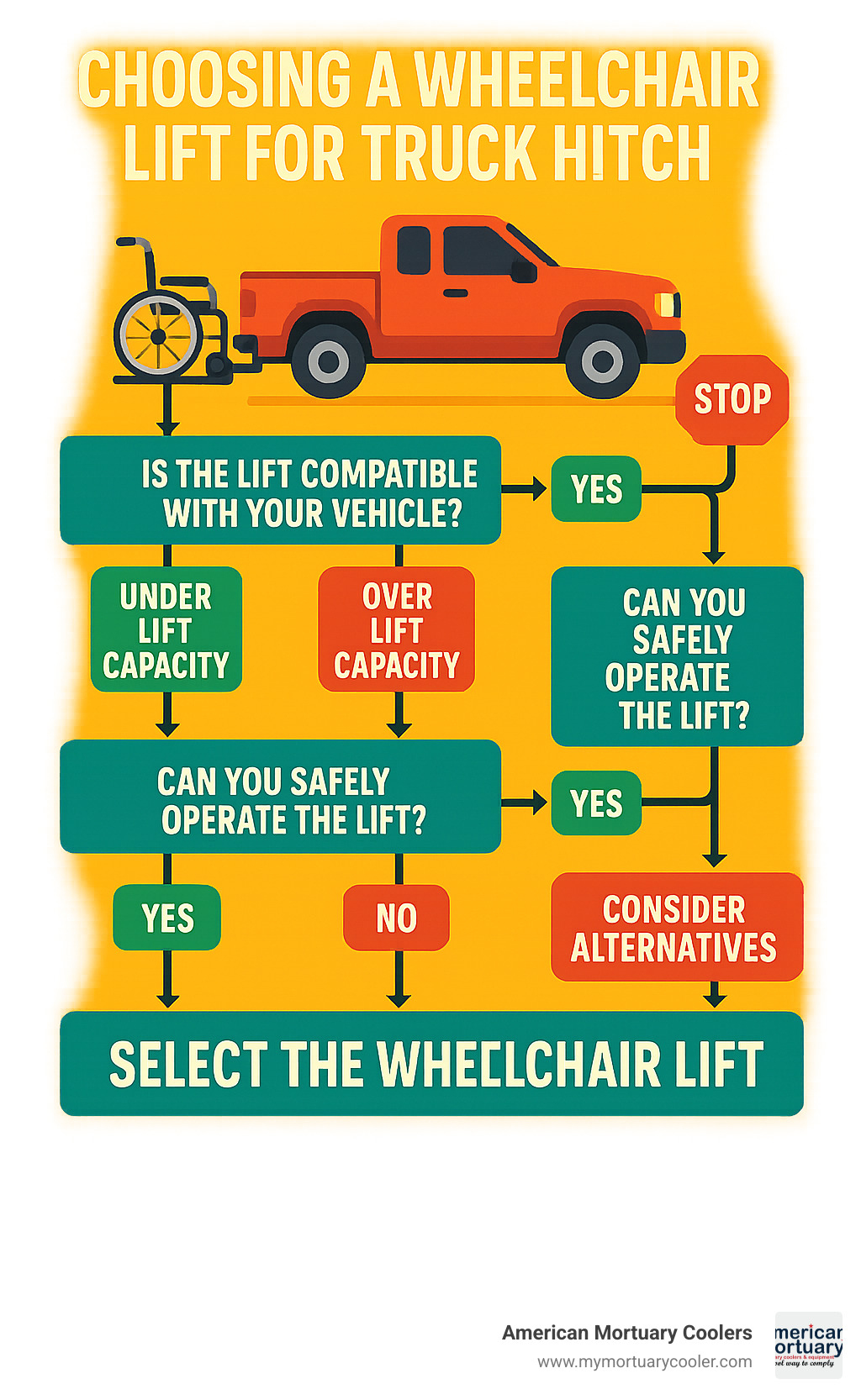
Basic wheelchair lift for truck hitch terms:
Wheelchair Lift for Truck Hitch: Essentials
Understanding the basics of a wheelchair lift for truck hitch is crucial before making a purchase decision. These exterior-mounted systems offer a practical solution for transporting mobility devices without sacrificing your truck's interior space.
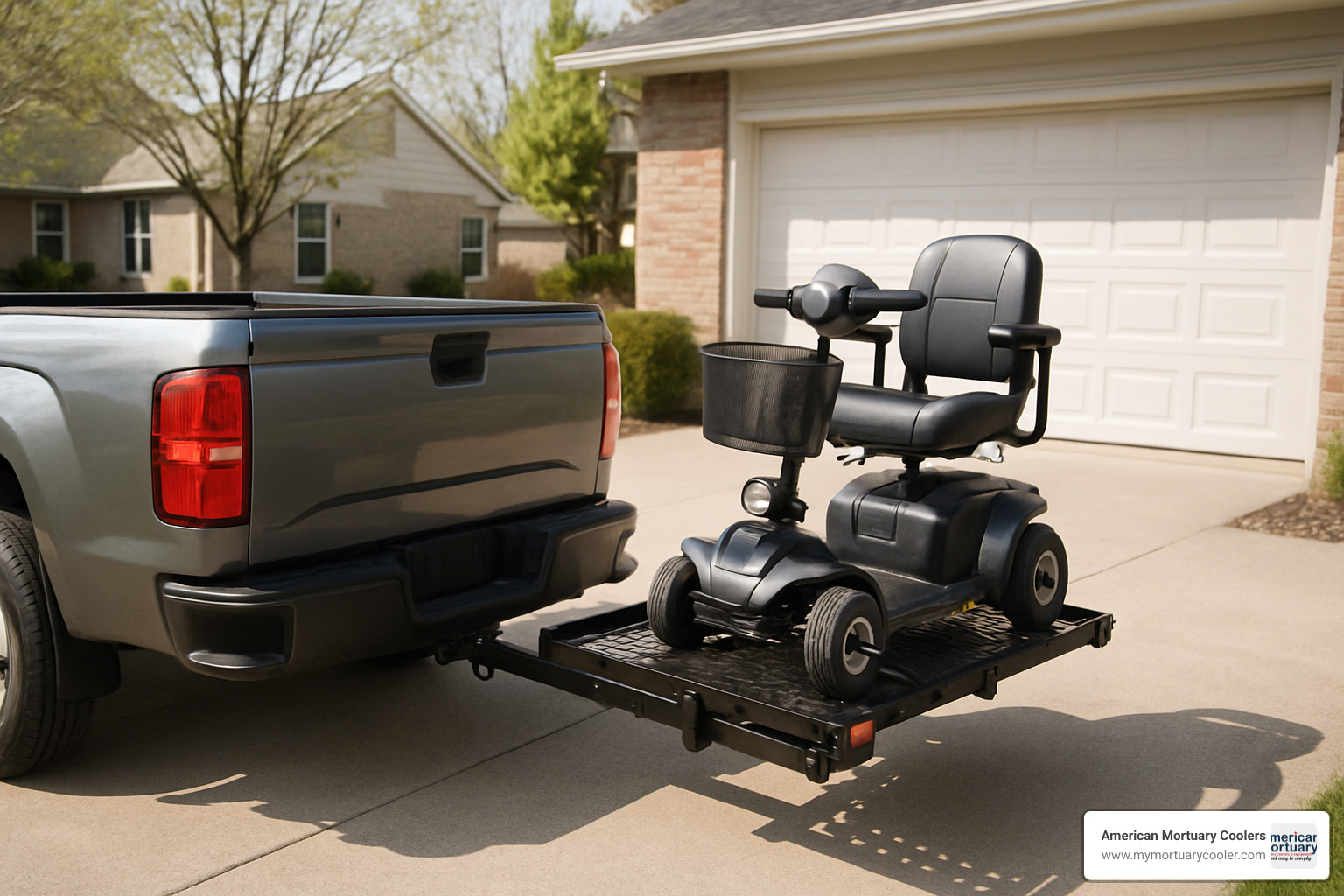
What Is a Wheelchair Lift for Truck Hitch?
Think of a wheelchair lift for truck hitch as your mobility device's personal elevator that rides on the outside of your truck. These clever systems plug right into your truck's hitch receiver, creating a secure platform to transport your wheelchair or scooter without sacrificing an inch of your truck's interior space.
Most hitch-mounted lifts are straightforward in design but mighty in function. They typically include a sturdy mounting bracket that connects snugly to your hitch receiver, a platform or lifting arm that does the heavy lifting, and either a manual operation system or one powered by your vehicle's 12V battery. The best part? Everything stays secure with reliable tie-downs that keep your mobility device from going anywhere during transport.
As one mobility specialist told me with a smile, "These lifts are like having an extra passenger that rides on the back instead of taking up a seat inside." I couldn't agree more – they're the perfect solution when you need your truck's interior for actual passengers or cargo.
Key Benefits vs. Interior Lifts
When you compare exterior hitch-mounted lifts to their interior counterparts, the advantages become crystal clear. For starters, you get to keep all your seating and cargo space intact – no more choosing between bringing your wheelchair or your groceries home!
The loading process is also much more straightforward. Instead of navigating tight interior spaces (and possibly bumping your knuckles in the process), you have the wide-open outdoors to work with. Your truck's interior remains exactly as the manufacturer intended – no cutting, drilling, or modifying required.
Many of my customers appreciate the cost savings too. Hitch lifts typically cost significantly less than interior systems, leaving more money in your pocket. And if you upgrade your vehicle down the road? No problem! Most hitch lifts can move with you to your new truck, provided it has a compatible hitch receiver.
I remember talking with Sarah, whose daughter uses a wheelchair. "Before getting our hitch lift, I dreaded every trip," she told me. "Now loading her chair is almost effortless – it's given us our freedom back."
The main trade-off, of course, is that your mobility device will be exposed to whatever Mother Nature throws at it during transport. But many manufacturers offer weatherproof covers as accessories, giving your valuable equipment an extra layer of protection.
Who Can Safely Operate a Hitch Lift?
Let's be honest – these lifts are fantastic, but they're not for everyone. To safely operate a wheelchair lift for truck hitch without assistance, you generally need a specific set of abilities.
You should be able to walk from the driver's seat to the back of your truck and stand steady for about three minutes while operating the lift. You'll need enough strength and coordination to place your mobility device onto the platform, press the controls (or manually operate the lift), and secure the tie-down straps properly.
These requirements ensure you can safely load and unload your equipment without putting yourself at risk. If these tasks sound challenging, don't worry – you might just need a helping hand from a caregiver, or perhaps a different mobility solution would better suit your needs.
As Robert, a caregiver for his wife, shared with me, "Getting the hitch lift changed everything for us. I can take her to appointments without the backbreaking work of loading her power chair into our truck bed. It's given us both more independence."
Whether you're looking for yourself or helping a loved one find the right solution, understanding these essentials will help you make an informed decision about whether a wheelchair lift for truck hitch is right for your situation.
Lift Types, Capacities & Leading Models
The market offers a wonderful variety of wheelchair lift for truck hitch options to fit your specific mobility needs. Whether you're looking for something simple or heavy-duty, there's likely a perfect match for your truck and mobility device.
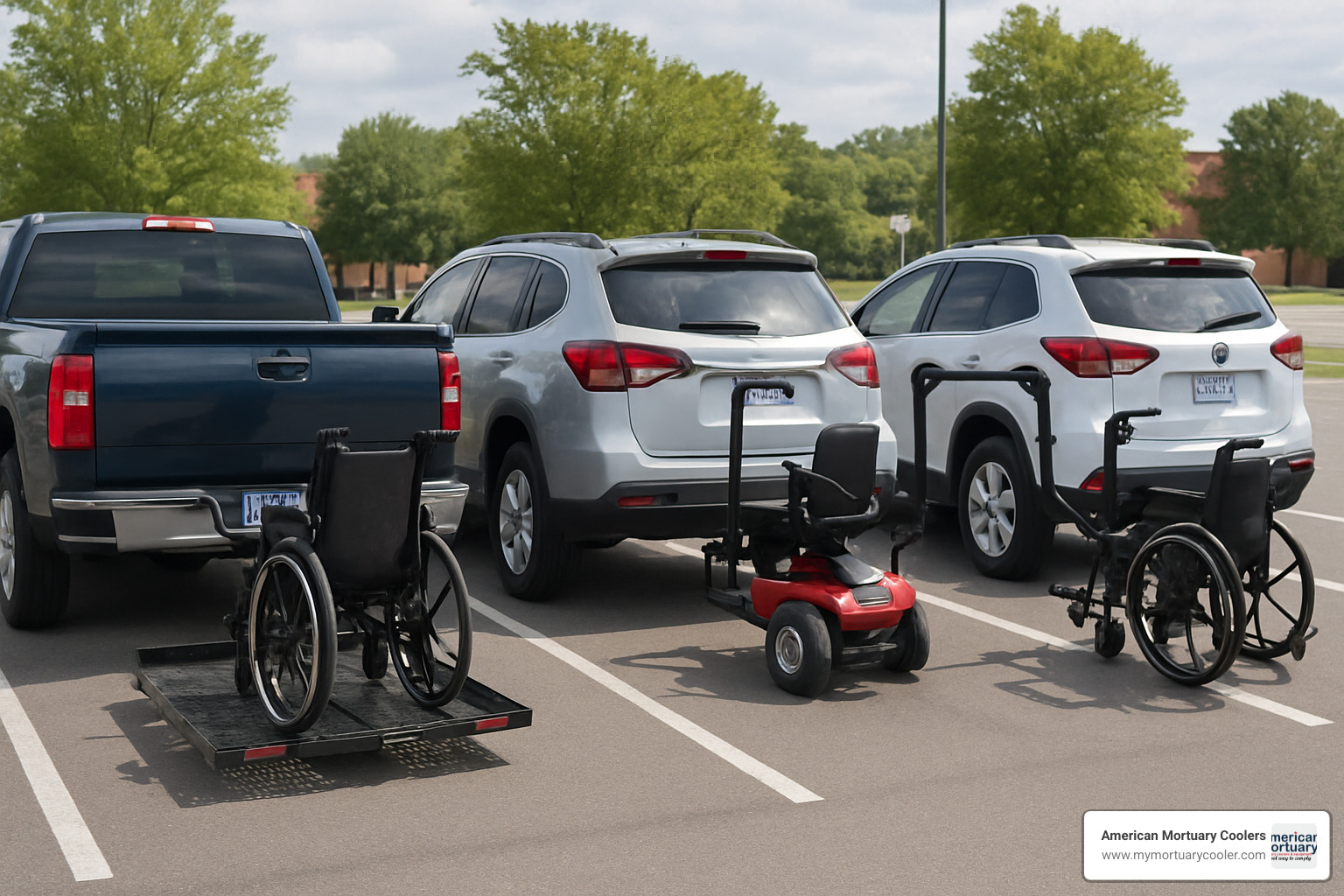
Platform Lifts: Drive-On Convenience
Platform lifts have become the go-to choice for many truck owners, and it's easy to see why. These user-friendly systems feature a flat surface that lowers all the way to the ground, making it incredibly simple to drive your mobility device directly onto the lift.
The Harmar AL100 is a customer favorite, supporting up to 350 pounds with its sturdy platform and automatic folding mechanism. Need something with a bit more muscle? The AL100HD bumps the capacity up to 400 pounds while maintaining the same convenient features. Both models include thoughtful details like automatic hold-down arms that keep your mobility device secure during transport.
The Bruno Out-Sider also deserves a mention for its straightforward operation. As one happy customer told us, "It's been so easy running errands since getting my vehicle lift! I can just guide my scooter off the lift and shop without worrying about transportation."
These platform lifts connect to your truck's battery, doing all the heavy lifting for you with the push of a button. When not in use, they fold up neatly against your vehicle, staying out of the way until your next trip.
Hoist & Crane Lifts for Truck Beds
If you'd prefer to keep your mobility device in your truck bed rather than behind your vehicle, a hoist-style lift might be your perfect match. These clever systems use a swing-arm design to lift your wheelchair or scooter and place it directly into your truck bed.
The Bruno Out-Rider stands out in this category with its smooth operation and reliable design. What makes these systems particularly appealing is that they leave your hitch free for towing – meaning you can transport your mobility device and still pull a trailer when needed.
Truck bed solutions offer excellent protection from the elements, keeping your mobility device shielded from rain, snow, and road debris. They're especially popular with pickup owners who frequently travel in areas with unpredictable weather or who need to maintain their towing capabilities.
Trailer & Specialty Solutions
Sometimes the best solution isn't attached to your truck at all. Trailer-based systems like the Bruno Chariot and ScootaTrailer offer a different approach to mobility device transport.
The ScootaTrailer is particularly impressive, handling mobility devices up to a whopping 600 pounds. The beauty of these pull-behind solutions is their universal compatibility – if your truck can tow, it can use one of these specialized trailers.
"I was worried about modifying my new truck," one customer shared, "but the ScootaTrailer gave me all the functionality I needed without changing a thing on my vehicle."
These trailers are worth considering if you have an especially heavy mobility device or if you prefer not to make any permanent modifications to your truck.
Heavy-Duty, Manual & Micro Options
Not every situation calls for the same solution, which is why manufacturers have developed specialized options for unique needs.
For the heaviest mobility devices, the Harmar AL001 offers an impressive 500-pound capacity with an oversized platform measuring 28" by 48". This gentle giant handles nearly any mobility device without breaking a sweat.
On the other end of the spectrum, the Harmar AL003 Tilt-N-Tote offers a lightweight, manual solution for transporting folding wheelchairs. Weighing just 25 pounds installed, it can carry manual wheelchairs up to 100 pounds – perfect for occasional use or as a backup system.
The AL050 Micro Wheelchair Lift fills an important niche for smaller vehicles with Class I hitches. With a 135-pound capacity, it's ideal for lightweight, take-apart power wheelchairs and compact mobility scooters.
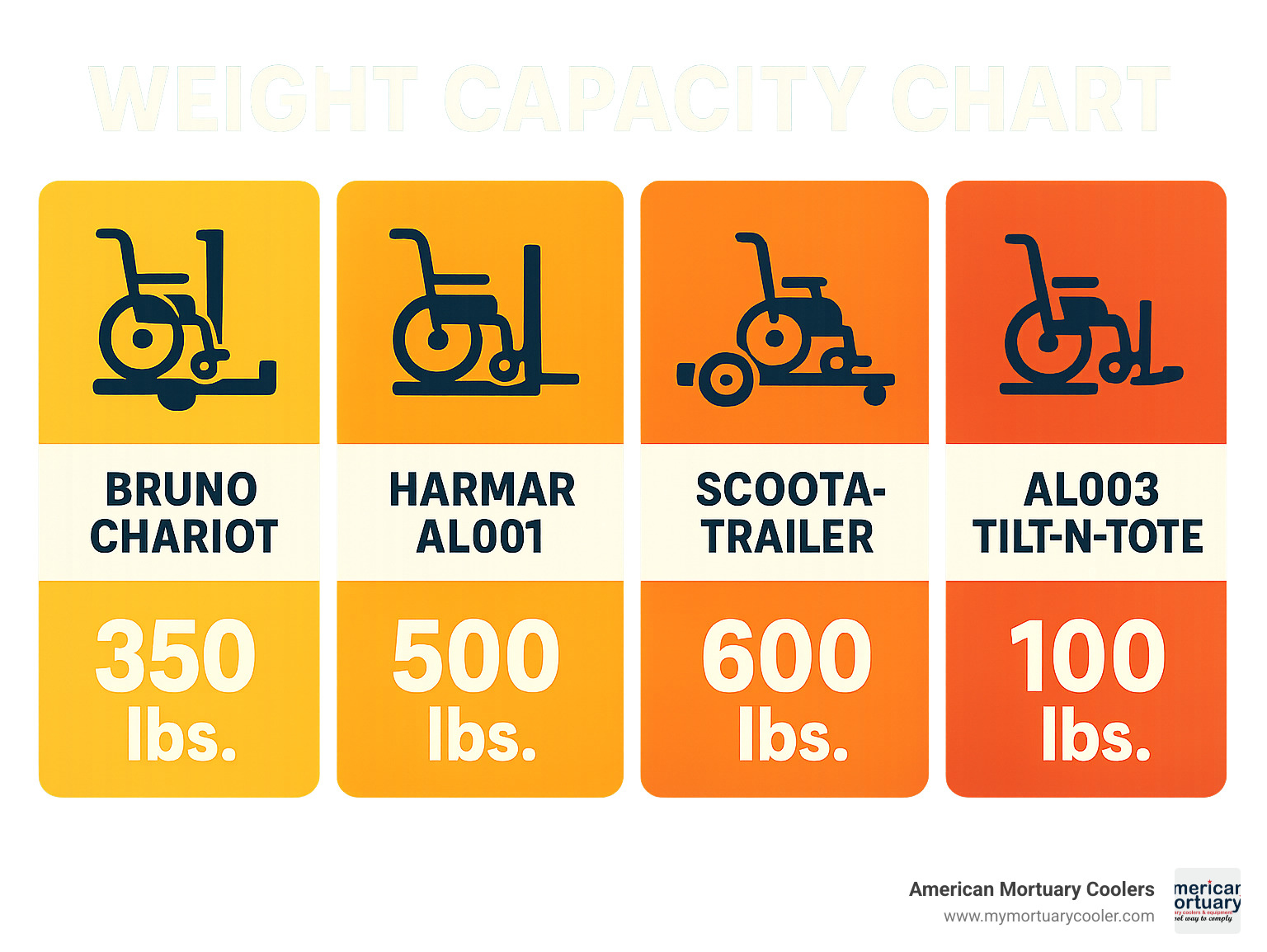
With so many options available, you're sure to find a wheelchair lift for truck hitch that perfectly matches your needs. If you're exploring mobility solutions for specialized transportation needs, you might also find our guide to Portable Step Lifts helpful as you consider all your options.
Compatibility, Hitch Classes & Installation Requirements
Finding the perfect match between your truck and your mobility device isn't just about convenience—it's essential for safety. Let's break down everything you need to know about making sure your wheelchair lift for truck hitch works perfectly with your vehicle.
Hitch Classes & Tongue-Weight Basics
Think of your truck's hitch class as its lifting strength certificate. Each class tells you exactly how much weight your truck can safely handle:
Class I hitches are the lightweights—handling up to 2,000 pounds of gross trailer weight and about 200 pounds of tongue weight. These are rarely sufficient for most wheelchair lifts.
Class II hitches step things up to 3,500 pounds gross weight and 350 pounds tongue weight. This is typically the minimum you'll need for a basic wheelchair lift for truck hitch.
Class III hitches are the workhorses most lift owners rely on, supporting up to 8,000 pounds gross weight and 800 pounds tongue weight—plenty for most mobility devices and lifts combined.
Class IV and V hitches are the heavy-duty champions, handling 10,000-12,000+ pounds and tongue weights of 1,000-1,200+ pounds. These are overkill for most personal mobility needs but provide extra peace of mind.
Tongue weight is simply how much downward force your hitch can handle. According to scientific research on measuring tongue weight, experts recommend this weight should be about 10-15% of whatever you're hauling for best stability. Think of it as the "sweet spot" for balance.
If your truck came with a lower class hitch than needed, you have options. Some folks use adapter sleeves, but I'd recommend upgrading to a proper higher-class hitch for safety's sake. Your mobility depends on it!
Matching Lift Capacity to Your Mobility Device
This part is straightforward but crucial: your lift needs to be strong enough for your specific mobility device. Here's how to get it right:
First, weigh your wheelchair or scooter with all accessories attached. Don't guess—actual weight matters tremendously for safety. If you can't weigh it at home, most medical supply stores will help you out.
Next, measure your device's wheelbase (the distance between front and rear wheels) to ensure it will fit properly on the lift platform. Those extra inches matter!
Finally, check the platform dimensions of any lift you're considering. Your mobility device needs to fit comfortably with a little room to spare.
Most manual wheelchair carriers handle around 100-150 pounds, while standard platform lifts typically support 350 pounds. If you have a heavier power chair or scooter, look for heavy-duty models rated for 400-450 pounds. Universal carriers can manage up to 500 pounds, and trailer options push that limit to 600 pounds.
Always build in a safety buffer by choosing a lift that exceeds your mobility device's weight by at least 10%. Better to have too much capacity than not enough!
Can You Transfer a Lift Between Vehicles?
One of the nicest perks of a wheelchair lift for truck hitch is that you're not necessarily married to one vehicle forever. Most systems can move with you to your next truck if needed.
The transferability comes down to three main factors:
Universal hitch mounting means most lifts are designed to work with standard hitch receivers. As long as your new truck has a compatible hitch class, you're halfway there.
Wiring harness design varies between manufacturers. Some use plug-and-play universal wiring that transfers easily, while others might require more work.
Swing-away accessories that came with your original lift typically transfer right along with the main unit, saving you from buying everything new.
As one customer shared with me, "I've moved my Bruno lift through three different trucks over eight years—it's outlasted the vehicles themselves!"
While technically possible as a DIY project, I'd recommend having a professional handle the transfer to ensure everything works perfectly in its new home.
Installation Steps & Certifications
While some handy truck owners might be tempted to install their own lift, this isn't typically a project for weekend warriors. Professional installation ensures everything works safely and correctly.
The basic installation process involves:
- Properly mounting the lift to your truck's hitch receiver
- Installing a wiring harness connected to your vehicle's 12V battery
- Testing operation and making necessary adjustments
- Securing all components and connections for road safety
The gold standard in the industry is to look for NMEDA QAP (National Mobility Equipment Dealers Association Quality Assurance Program) Certified Technicians. These pros have specialized training to ensure your lift meets all safety standards.
Professional installation typically takes 2-3 hours and might be included in your purchase price or charged separately. Most manufacturers provide dealer locator tools on their websites, making it easy to find certified installers in your area.
This isn't just about convenience—it's about safety. A properly installed wheelchair lift for truck hitch gives you confidence every time you hit the road with your mobility device.
Safe Operation, Maintenance & Weather Tips
Proper operation and maintenance of your wheelchair lift for truck hitch are essential for safety, reliability, and longevity. This section covers best practices for using your lift, protecting it from weather conditions, and keeping it in optimal working condition.
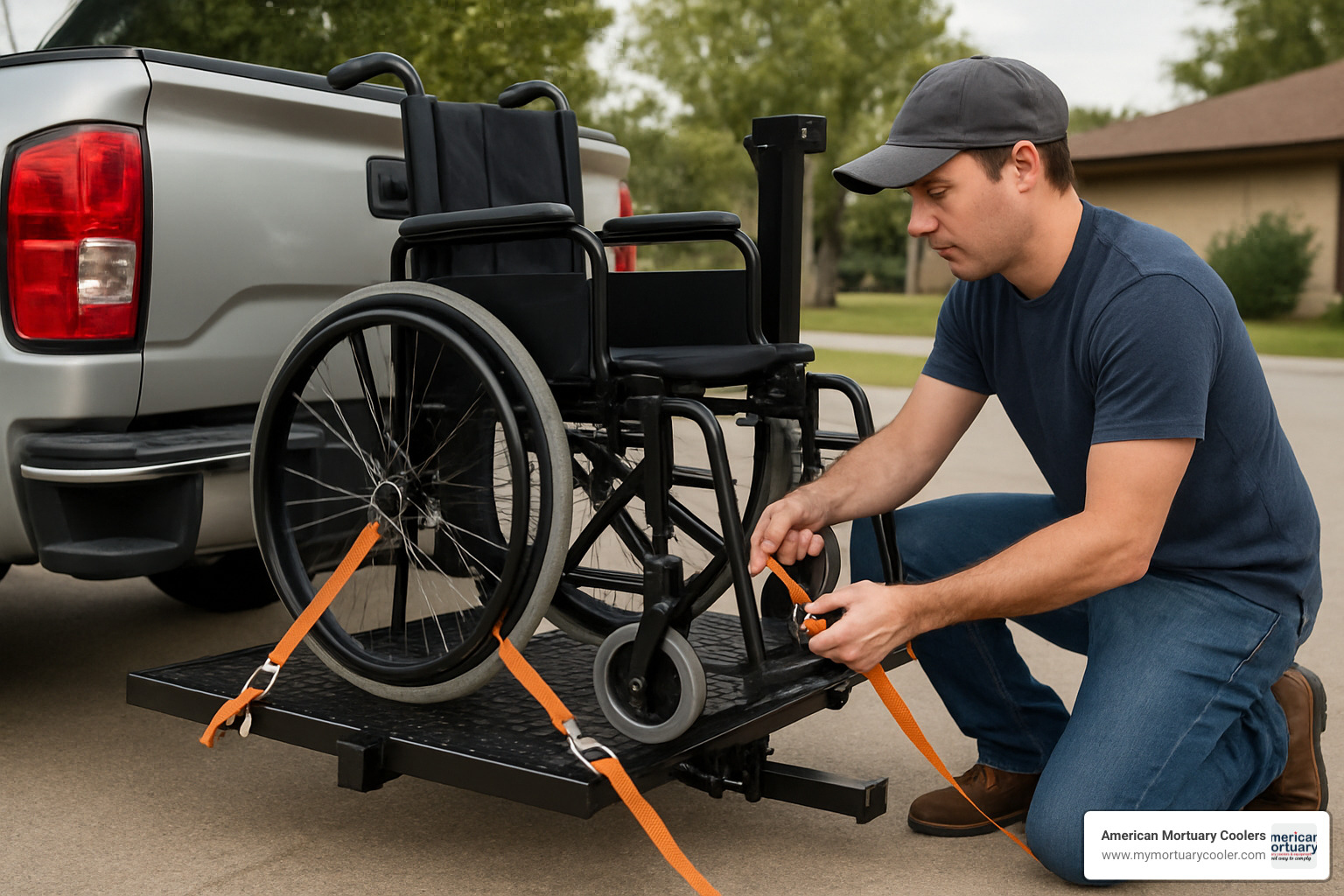
Operating Your Lift & Securing the Device
Getting comfortable with your wheelchair lift for truck hitch operation isn't just about convenience—it's about safety. Let's walk through the basics together.
When you're ready to use your lift, always start by parking on level ground with plenty of space behind your truck. No one wants to struggle with loading while parked on a hill! Insert your key if your model requires one, and activate the lift. As the platform lowers smoothly to the ground, take a moment to ensure it's fully deployed before proceeding.
Now comes the fun part—driving or placing your mobility device onto the platform. Once positioned correctly, you'll need to secure it properly. Most lifts come with specific restraint systems, which might include a hold-down foot (a mechanical arm that locks onto your mobility device's frame), Q'Straint retractors (those handy self-tensioning straps), or manual straps that you'll tighten yourself.
"My husband's powerchair fits safely on our hitch lift," one user shared with us. "We love it. I just drive it on, secure it with the hold-down arm, and we're ready to go."
Don't forget to familiarize yourself with the manual backup operation system—usually a hand crank—before you actually need it. There's nothing worse than finding your lift's battery is dead when you're miles from home with no idea how to operate the backup system!
Weather & Road Conditions Considerations
Since your mobility device will be riding outside your vehicle, it's going to face whatever Mother Nature throws its way. A little preparation goes a long way toward protection.
Most manufacturers offer weatherproof covers custom-fitted to their lift models, which are worth every penny if you live somewhere with frequent rain or snow. For smaller manual wheelchairs, protective bags can provide additional shielding. And don't forget about those weather-sensitive accessories—it's often best to remove and store them indoors when possible.
Road conditions deserve your attention too. Rain and snow aren't just uncomfortable—they can cause rusting on unprotected metal components over time. Road salt is particularly nasty, as it's highly corrosive to metal parts. Even mud and debris can work their way into moving parts and electrical connections, causing problems down the road.
The good news is that modern wheelchair lift for truck hitch systems typically feature aluminum decks and weatherproofed electrical components. Still, as one dealer wisely advises: "In winter months, we recommend washing your lift weekly to remove road salt and applying a silicone-based lubricant to moving parts." That's solid advice that can extend your lift's lifespan considerably.
Routine Maintenance & Troubleshooting
Think of your lift maintenance like taking care of a trusted friend—regular attention keeps the relationship running smoothly. A simple maintenance routine might look like this:
Take a few minutes each week for a visual inspection and cleaning. Monthly, show some love to those moving parts with proper lubrication. Quarterly, check those electrical connections to make sure everything's tight and corrosion-free. And annually, treat your lift to a comprehensive inspection by a certified technician who knows all its quirks and needs.
The most common maintenance tasks aren't complicated. Greasing pivot points with marine-grade grease keeps everything moving smoothly. Battery draw checks ensure your lift isn't secretly draining your vehicle's battery. Bolt tightening prevents that annoying rattling on the road. And electrical connection cleaning removes the corrosion that can interrupt power flow.
When things don't go as planned, a little troubleshooting knowledge goes a long way. If your lift won't power on, check those electrical connections and your vehicle battery first. Jerky operation usually means it's time for lubrication or clearing obstructions. Unusual noises? That's your lift's way of telling you something's loose or worn. And if it refuses to fold or unfold properly, look for obstructions and add lubrication to those hinges.
Your owner's manual is gold when it comes to troubleshooting—keep it somewhere handy rather than buried in your glove compartment. Most manufacturers have put significant thought into their troubleshooting guides, saving you time and frustration when issues arise.
Proper care of your wheelchair lift for truck hitch isn't just about protecting your investment—it's about ensuring reliable mobility when you need it most. A few minutes of regular maintenance can prevent hours of inconvenience down the road.
Cost, Financing, Buying Options & FAQs
Navigating the financial side of purchasing a wheelchair lift for truck hitch doesn't have to be overwhelming. Let's break down what you can expect to pay, how to make it more affordable, and answer those burning questions you might have.
How Much Does a Hitch Lift Cost?
When it comes to pricing, wheelchair lift for truck hitch systems vary widely based on their capabilities and features:
Manual wheelchair carriers are the most budget-friendly option, typically ranging from $500-$1,200. If you're looking for something simple to transport a lightweight manual chair, these can be perfect without breaking the bank.
Basic platform lifts start around $1,200 and can go up to $2,500, offering powered operation for standard mobility devices. The heavy-duty versions with higher weight capacities will run you between $2,500-$3,500, while specialty or custom solutions can exceed $4,500.
Don't forget to factor in those "extra" costs that can sneak up on you. Swing-away accessories that let you access your truck's tailgate will add $300-$600, weather covers typically cost $75-$150, and professional installation might run $200-$500 if not included in your purchase.
Used lifts can be a fantastic option if you're on a tight budget. Many dealers offer pre-owned equipment at 30-50% off retail prices. As one mobility specialist told me with a wink, "The early bird gets the wheelchair lift!" – meaning these used deals go quickly when they become available.
Financing, Warranties & Assistance Programs
Good news – you don't necessarily have to pay for everything upfront! Many lift manufacturers offer payment plans specifically designed for mobility equipment. Medical equipment loans, credit card financing with special terms, and services like PayTomorrow can help spread the cost over time.
When it comes to protection, most new lifts include manufacturer warranties ranging from 1-3 years. Companies like MobilityWorks typically include a 1-year labor warranty and 1-year roadside assistance as standard with vehicle lifts. Extended warranties are usually available if you want additional peace of mind.
Don't miss out on potential rebates and assistance programs:
- Many major vehicle manufacturers offer up to $1,000 rebates when you purchase mobility equipment for newly purchased or leased vehicles
- Veterans' benefits often cover part or all of mobility equipment costs
- Some states provide tax incentives for disability-related vehicle modifications
One happy customer shared, "The rebate from my truck manufacturer covered almost a quarter of my lift cost – I had no idea until the dealer told me to check!"
Where Can I Buy & Have One Installed?
You've got options when it comes to purchasing your wheelchair lift for truck hitch:
Local mobility dealers offer the advantage of hands-on demonstrations and personalized service. You can actually see and touch the equipment before buying, and installation is often included or readily available. The downside? Prices are typically higher than online options.
Online retailers like Exterior lifts & carriers usually offer lower prices and a wider selection of models. The trade-off is you'll need to arrange installation separately, though many online retailers can connect you with local certified installers.
Speaking of installation, I strongly recommend working with NMEDA QAP Certified Technicians. These professionals have specialized training in mobility equipment installation and can ensure your lift is properly mounted and wired. Most manufacturer websites feature dealer locator tools to help you find qualified installers near you.
As one mobility consultant wisely put it, "Our Certified Mobility Consultants don't just sell you equipment – they provide a complete assessment of your wheelchair, vehicle type, weight requirements, travel lifestyle, and other considerations to recommend the right lift solution."
Frequently Asked Questions about Wheelchair Lift for Truck Hitch
Q: Can a hitch-mounted lift be installed on any truck? A: While most trucks can accommodate these lifts, your truck needs at least a Class II hitch (or the ability to have one installed). Some compact trucks might have limited tongue weight capacity that could restrict your options.
Q: How much weight can a typical wheelchair lift for truck hitch support? A: Standard lifts typically handle 350-400 pounds, but the range is wide – from 100 pounds for manual wheelchair carriers up to 600 pounds for heavy-duty and trailer options. Always match the lift capacity to your mobility device with a little extra margin for safety.
Q: Do I need to modify my mobility device to use a hitch lift? A: Good news – most modern hitch lifts are designed to work with unmodified mobility devices. Universal carriers like the Harmar AL001 are specifically designed to transport virtually any mobility device without alterations.
Q: Can I still access my truck's tailgate with a hitch lift installed? A: Many lifts fold down or to the side when not in use, allowing tailgate access. If your chosen model doesn't fold, consider adding a swing-away accessory (typically $300-$600) that lets you move the entire lift aside to access your tailgate.
Q: Is a wheelchair lift for truck hitch covered by insurance? A: This varies widely by provider. Some health insurance plans and auto insurance policies provide partial coverage for mobility equipment. Medicare typically doesn't cover vehicle modifications, though some Medicare Advantage plans might. It's always worth calling your insurance provider to check your specific coverage.
Q: Can I install a wheelchair lift myself? A: While technically possible if you're mechanically inclined, I don't recommend DIY installation. Professional installation ensures safety, proper electrical connections, and maintains your warranty. As one installer told me, "I've fixed more DIY installations than I care to count – and it always costs more than if they'd done it right the first time."
Conclusion
Choosing the perfect wheelchair lift for truck hitch isn't just about buying equipment—it's about investing in your independence and quality of life. Throughout this guide, we've walked through everything you need to know to make a choice that truly fits your lifestyle and needs.
Final Selection Checklist:
- ✓ Confirm your truck's hitch class and tongue weight capacity
- ✓ Verify your mobility device's weight and dimensions
- ✓ Assess user capabilities for operating the lift
- ✓ Determine your budget and explore financing options
- ✓ Research warranties and service options
- ✓ Locate certified dealers and installers in your area
The right lift becomes an extension of your vehicle and lifestyle. Take your time with this decision—measure twice, purchase once, as they say in the mobility world. And don't hesitate to request in-person demonstrations from dealers. Nothing beats seeing how a lift actually operates with your specific mobility device and truck setup.
Here at American Mortuary Coolers, we understand the importance of equipment you can count on day after day. While our primary focus is providing reliable mortuary cooling systems nationwide, we've learned that both industries share core values: the need for durability, dependable performance, and customized solutions that work for individual situations.
I've seen how the right mobility equipment transforms daily life for our customers. One gentleman recently told me, "Getting this hitch lift was like getting a piece of my life back—I can go fishing again without depending on my son to load my scooter." These moments of regained independence make all the research worthwhile.
For those exploring additional mobility solutions beyond truck hitch lifts, we invite you to check out our More info about Mobi Medical equipment resources, where you'll find our complete mobility product lineup.
Your journey to improved mobility and independence is important, and selecting the right wheelchair lift for truck hitch is a significant step forward. By taking the time to research, ask questions, and find the perfect match for your specific needs, you're investing in years of freedom and convenience. And isn't that what mobility equipment is truly all about?
















